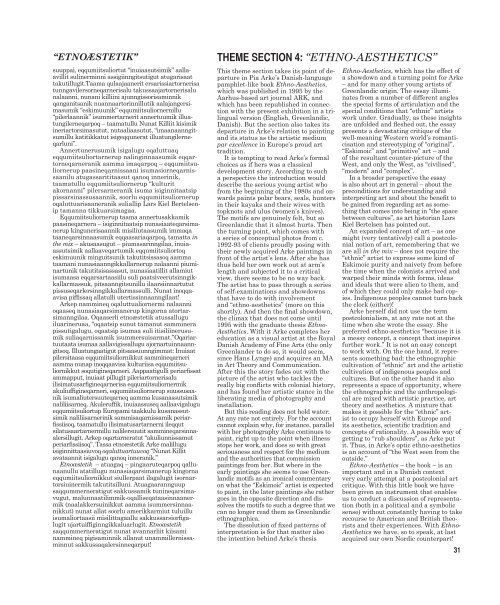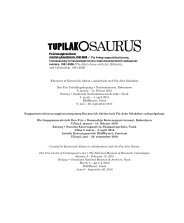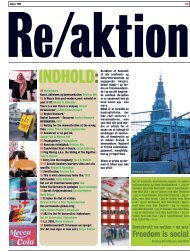tupilakosaurus - Print matters!
tupilakosaurus - Print matters!
tupilakosaurus - Print matters!
Create successful ePaper yourself
Turn your PDF publications into a flip-book with our unique Google optimized e-Paper software.
“ETNOÆSTETIK”<br />
suuppai, eqqumiitsuliortut “inuiaasutsimik” aallaavillit<br />
sulinerminni assigiinngitsutigut atugarisaat<br />
takutillugit.Taama qulaajaanerit ersarissiartornerisa<br />
tunngavilersorneqarnerisalu takussaajartornerisalu<br />
nalaanni, nunani killiini ajunngissorisaminnik<br />
qanganitsanik nuannaartorinnillutik aalajangersimasumik<br />
“eskimuunik” eqqumiitsuliornernillu<br />
“pilerlaannik” isummertarnerit annertuumik illuatungilerneqarpoq<br />
– taamatullu Nunat Killiit kisimik<br />
ineriartorsimasutut, nutaaliaasutut, “imaanaanngitsumillu<br />
katitikkatut isigeqqunerat illuatungilerneqarluni”.<br />
Annertunerusumik isigalugu oqaluttuaq<br />
eqqumiitsuliortarnerup nalinginnaasumik eqqartorneqarneranik<br />
aamma imaqarpoq – eqqumiitsuliornerup<br />
paasineqarnissaani isumasiorneqarnissaanilu<br />
atugassarititaasut qanoq innerinik,<br />
taamatullu eqqumiitsuliornerup “kulturit<br />
akornanni” pilersarneranik isuma isiginnitaatsip<br />
pissarsinassusaannik, soorlu eqqumiitsuliornerup<br />
oqaluttuarisaaneranik suliallip Lars Kiel Bertelsenip<br />
tamanna tikkuarsimagaa.<br />
Eqqumiitsuliornerup taama annertusakkamik<br />
paasineqarnera – isiginnitaatsip nunasiaateqarsimanerup<br />
kingunerisaannik misiliutaasumik immaqa<br />
taaneqarsinnaasumik eqqaasariaqarpoq, tamatta in<br />
the mix – akusaasugut – piumasarinngilaa, inuiaassutsimik<br />
aallaaveqartumik eqqumiitsuliortoq<br />
eskimuunik minguitsunik takutitsissasoq aamma<br />
taamani nunasiaanngikkallarnerup nalaanni piuminartunik<br />
takutitsisassasut, nunasiaatillit allamiut<br />
isumaasa eqqarsartaasiilu suli paatsiveerutsinngikkallarmassuk,<br />
pitsaanngitsunillu ilaarsiinnartutut<br />
pissuseqarlersinngikkallarmassulli. Nunat inoqqaavisa<br />
piffissaq allatulli utertissinnaanngilaat!<br />
Arkep nammineq oqaluttualiornermi nalaanni<br />
oqaaseq nunasiaqarsimanerup kingorna atortarsimanngilaa.<br />
Oqaaserli etnoæstetik atussallugu<br />
iluarineruaa, “oqaatsip sunut tamanut samminera<br />
pissutigalugu, oqaatsip isumaa suli itisiliinerusumik<br />
suliaqarnissamik isummersuisarmat.”Oqariartuutaata<br />
isumaa aallavigissallugu ajornartuinnaanngitsoq.<br />
Illuatungaatigut pitsaasuunngimmat: Inuiaat<br />
pilersitaasa eqqumiitsuliornikkut sammineqarneri<br />
aamma nunap inoqqaavisa kulturiisa eqqumiitsuliornikkut<br />
soqutigineqarneri. Aappaatigulli periarfissat<br />
ammapput, inuiaat pillugit pileriartornerisalu<br />
ilisimatusarfigineqarnerisa eqqumiitsuliornermik<br />
akuliuffigineqarneri, eqqumiitsuliornerup suussusaanik<br />
isumaliutersuuteqarneq aamma kusanassutsimik<br />
naliliisarneq. Akuleruffik, inuiaassuseq aallaavigalugu<br />
eqqumiitsuliortup Europami taakkulu kusanassutsimik<br />
naliliisarnerinik sammisaqarnissamik periarfissiisoq,<br />
taamatullu ilisimatusartarnerni ileqqut<br />
silatusaartarnermillu nalilersuutit sammineqarsinnaalersillugit.<br />
Arkep oqartarneratut “akuliunnissamut<br />
periarfissiisoq”. Tassa etnoæstetik Arke malillugu<br />
isiginnittaasiuvoq oqaluttuartuuvoq “Nunat Killit<br />
avataannit isigalugu qanoq inneranik.”<br />
Etnoæstetik – atuagaq – pingaaruteqarpoq qallunaanullu<br />
atatillugu nunasiaqarsimanerup kingorna<br />
eqqumiitsuliornikkut siullerpaat ilagalugit isornartorsiuinermik<br />
takutitsilluni. Atuagaarannguup<br />
saqqummerneratigut sakkussamik tunineqarsimavugut,malunnaatilimmik-oqalliseqataasinnaanermik<br />
(naalakkersuinikkut aamma isummersinnaanikkut)<br />
nunat allat soorlu amerikkarmiut tuluillu<br />
isumaliortaasii misilittagaallu sakkussarsiorfigalugit<br />
ujartuiffiginngikkaluarlugit. Etnoæstetik<br />
saqqummerneratigut nunat avannarliit kiisami<br />
nammineq pigisaminnik allanut unammillernissaminnut<br />
sakkussaqalersinneqarput!<br />
THEME SECTION 4: “ETHNO-AESTHETICS”<br />
This theme section takes its point of departure<br />
in Pia Arke’s Danish-language<br />
pamphlet-like book Ethno-Aesthetics,<br />
which was published in 1995 by the<br />
Aarhus-based art journal ARK, and<br />
which has been republished in connection<br />
with the present exhibition in a trilingual<br />
version (English, Greenlandic,<br />
Danish). But the section also takes its<br />
departure in Arke’s relation to painting<br />
and its status as the artistic medium<br />
par excellence in Europe’s proud art<br />
tradition.<br />
It is tempting to read Arke’s formal<br />
choices as if hers was a classical<br />
development story. According to such<br />
a perspective the introduction would<br />
describe the serious young artist who<br />
from the beginning of the 1980s and onwards<br />
paints polar bears, seals, hunters<br />
in their kayaks and their wives with<br />
topknots and ulus (women’s knives).<br />
The motifs are genuinely felt, but so<br />
Greenlandic that it almost hurts. Then<br />
the turning point, which comes with<br />
a series of conceptual photos from c.<br />
1992-93 of clients proudly posing with<br />
their newly acquired Arke paintings in<br />
front of the artist’s lens. After she has<br />
thus held her own work out at arm’s<br />
length and subjected it to a critical<br />
view, there seems to be no way back.<br />
The artist has to pass through a series<br />
of self-examinations and showdowns<br />
that have to do with involvement<br />
and “ethno-aesthetics” (more on this<br />
shortly). And then the final showdown,<br />
the climax that does not come until<br />
1995 with the graduate thesis Ethno-<br />
Aesthetics. With it Arke completes her<br />
education as a visual artist at the Royal<br />
Danish Academy of Fine Arts (the only<br />
Greenlander to do so, it would seem,<br />
since Hans Lynge) and acquires an MA<br />
in Art Theory and Communication.<br />
After this the story fades out with the<br />
picture of the artist who tackles the<br />
really big conflicts with colonial history,<br />
and has found her artistic stance in the<br />
liberating media of photography and<br />
installation.<br />
But this reading does not hold water:<br />
At any rate not entirely. For the account<br />
cannot explain why, for instance, parallel<br />
with her photography Arke continues to<br />
paint, right up to the point when illness<br />
stops her work, and does so with great<br />
seriousness and respect for the medium<br />
and the authorities that commission<br />
paintings from her. But where in the<br />
early paintings she seems to use Greenlandic<br />
motifs as an ironical commentary<br />
on what the “Eskimoic” artist is expected<br />
to paint, in the later paintings she rather<br />
goes in the opposite direction and dissolves<br />
the motifs to such a degree that we<br />
can no longer read them as Greenlandic<br />
ethnographica.<br />
The dissolution of fixed patterns of<br />
interpretation is for that matter also<br />
the intention behind Arke’s thesis<br />
Ethno-Aesthetics, which has the effect of<br />
a showdown and a turning point for Arke<br />
– and for many other young artists of<br />
Greenlandic origin. The essay illuminates<br />
from a number of different angles<br />
the special forms of articulation and the<br />
special conditions that “ethnic” artists<br />
work under. Gradually, as these insights<br />
are unfolded and fleshed out, the essay<br />
presents a devastating critique of the<br />
well-meaning Western world’s romanticisation<br />
and stereotyping of “original”,<br />
“Eskimoic” and “primitive” art – and<br />
of the resultant counter-picture of the<br />
West, and only the West, as “civilised”,<br />
“modern” and “complex”.<br />
In a broader perspective the essay<br />
is also about art in general – about the<br />
preconditions for understanding and<br />
interpreting art and about the benefit to<br />
be gained from regarding art as something<br />
that comes into being in “the space<br />
between cultures”, as art historian Lars<br />
Kiel Bertelsen has pointed out.<br />
An expanded concept of art – as one<br />
might (very tentatively) call a postcolonial<br />
notion of art, remembering that we<br />
are all in the mix – does not require the<br />
“ethnic” artist to express some kind of<br />
Eskimoic purity and naivety from before<br />
the time when the colonists arrived and<br />
warped their minds with forms, ideas<br />
and ideals that were alien to them, and<br />
of which they could only make bad copies.<br />
Indigenous peoples cannot turn back<br />
the clock (either)!<br />
Arke herself did not use the term<br />
postcolonialism, at any rate not at the<br />
time when she wrote the essay. She<br />
preferred ethno-aesthetics “because it is<br />
a messy concept, a concept that inspires<br />
further work.” It is not an easy concept<br />
to work with. On the one hand, it represents<br />
something bad: the ethnographic<br />
cultivation of “ethnic” art and the artistic<br />
cultivation of indigenous peoples and<br />
cultures. But on the other hand it also<br />
represents a space of opportunity, where<br />
the ethnographic and the anthropological<br />
are mixed with artistic practice, art<br />
theory and aesthetics. A mixture that<br />
makes it possible for the “ethnic” artist<br />
to occupy herself with Europe and<br />
its aesthetics, scientific tradition and<br />
concepts of rationality. A possible way of<br />
getting to “rub shoulders”, as Arke put<br />
it. Thus, in Arke’s optic ethno-aesthetics<br />
is an account of “the West seen from the<br />
outside.”<br />
Ethno-Aesthetics – the book – is an<br />
important and in a Danish context<br />
very early attempt at a postcolonial art<br />
critique. With this little book we have<br />
been given an instrument that enables<br />
us to conduct a discussion of representation<br />
(both in a political and a symbolic<br />
sense) without constantly having to take<br />
recourse to American and British theorists<br />
and their experiences. With Ethno-<br />
Aesthetics we have, so to speak, at last<br />
acquired our own Nordic counterpart!<br />
31




